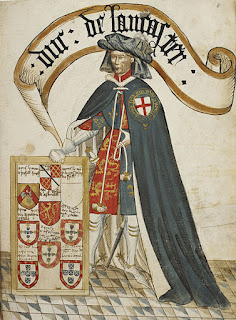Katherine Swynford (c.1350? - 10 May 1403) was the daughter of a knight from Hainaut. Her father, Paon de Roet (his and Katherine's arms are shown), followed
Philippa of Hainaut when she came to England to marry King Edward III. Katherine was a lady-in-waiting to the queen.
Just as kings found advantageous marriages for their offspring, so did they help their favorites marry well. Katherine Roet was married to Hugh Swynford, a knight in the retinue of John of Gaunt. Accordingly, Katherine was transferred to the household of Gaunt's wife, Blanche. When Blanche died in 1368, Katherine became lady-in-waiting to her daughters, Philippa and Elizabeth. Katherine and Hugh had three or four children.
In the same year that Hugh Swynford died, 1371, John of Gaunt married Constance of Castile and returned to England from the continent. Katherine was now lady-in-waiting to Constance, the new Duchess of Lancaster and also styled Queen of Castile. Katherine now had a little more to her name: Hugh was not wealthy, but the king and Gaunt made sure his estates in Lincolnshire became Katherine's (Hugh's son and heir being a minor, the estates would have become property of his overlords, the king and Gaunt). Gaunt also increased her annuity from 20 to 50 marks, a very decent sum, to help the upkeep of the estates.
In 1373, Katherine had a child, John Beaufort (the surname came from one of Gaunt's estates in Hainaut). The father was John of Gaunt. They had three more children, all while Constance of Castile was still alive. Gaunt did not exactly keep the relationship quiet: he gave Katherine an annuity and several estates as a sign of his favor.
Knowing that Katherine was the favorite of Gaunt (the most powerful man in England after the king), many would try to curry favor with her. The mayor of Leicester gave her a gift of 16 shillings' worth of wine, recorded as to "Lady Katherine Swynford, mistress of the Duke of Lancaster." That was in August 1375 and is the first public acknowledgement of the affair. The public in general, however, was appalled at the behavior, and the two were forced to break off the affair in 1381. Katherine left her position as lady-in-waiting to the woman whose husband she was sleeping with and settled in Lincoln, likely the Kettlethorpe estate from her deceased husband.
What did Constance think of this affair? Did she know? Gaunt was her best option for getting to the Castilian throne that had been usurped from her father, so she may have taken the bad with the potential good. Her Castilian ladies-in-waiting, however, likely noticed and complained: in 1373 they were all sent by Gaunt to Nuneaton Priory, a Benedictine monastery many days' journey from London. (They were allowed back a year later.)
Katherine was not completely personae non grata, however. King Richard II made her a Lady of the Garter in 1387. She also was brought back into royal service, so to speak, by joining the household of Mary de Bohun, Gaunt's daughter-in-law by virtue of marriage to his eldest son, Henry Bolingbroke (the future King Henry IV).
Constance of Castile, Duchess of Lancaster, died 24 March 1394 and was buried in Leicester. Gaunt and Katherine were now free to pursue an open relationship. They were still haunted by the scandal, and the shadow of adultery.
How they handled it, and what happened after, will be tomorrow's topic.








.jpg)


















